Ants, those tiny creatures that scurry around tirelessly, are fascinating social insects that have thrived on Earth for millions of years. With over 12,000 known species worldwide, ants belong to the family Formicidae and play crucial roles in ecosystems across the globe. These industrious insects are highly organized, living in complex societies called colonies where each ant has specific tasks and responsibilities.
Ant colonies consist of a queen ant who lays eggs, male ants whose sole purpose is to mate with the queen, and numerous worker female ants, who carry out various duties such as foraging for food or constructing nests. The division of labor within ant colonies is truly remarkable.
Some workers specialize in defending the colony against threats while others focus on gathering food or caring for the young. This harmonious cooperation allows ants to thrive in diverse environments ranging from forests to deserts.
Discover Our Expert Ant Extermination and Control Solutions! Delve into the efficiency of our skilled services in eradicating your ant infestation. Click here to explore further about our specialized ant control and extermination solutions!
Importance of ants in ecosystems
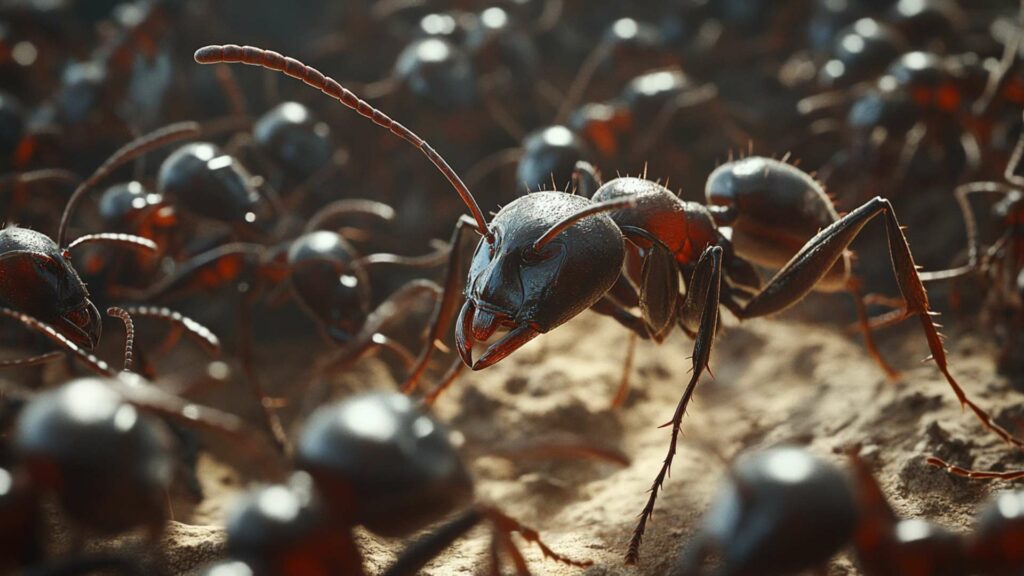
Despite their small size, ants have an immense impact on ecosystems worldwide. Their influence can be seen from their role as predators, scavengers, and even seed dispersers.
Ants are voracious feeders and help control populations of other insects by preying upon pests such as aphids or termites that can damage crops and vegetation. Furthermore, certain ant species form mutualistic relationships with honeydew-producing insects like aphids – they feed on the sweet secretions while protecting these tiny sap-sucking bugs from predators.
Ants also contribute to soil health through their nest-building activities. As they construct intricate tunnels underground or build conspicuous mounds above ground using soil particles they excavate diligently, they aerate the soil and improve its drainage properties.
These actions aid in nutrient cycling by decomposing organic matter and increasing microbial activity in the soil. While often overlooked due to their small size, ants are remarkable social insects that deserve recognition for their vital roles in ecosystems.
From their complex societies to their multifaceted ecological functions, ants demonstrate the power of collaboration and adaptability. So, the next time you encounter an ant scurrying across your path, take a moment to appreciate these tiny wonders and the vast web of life they influence.
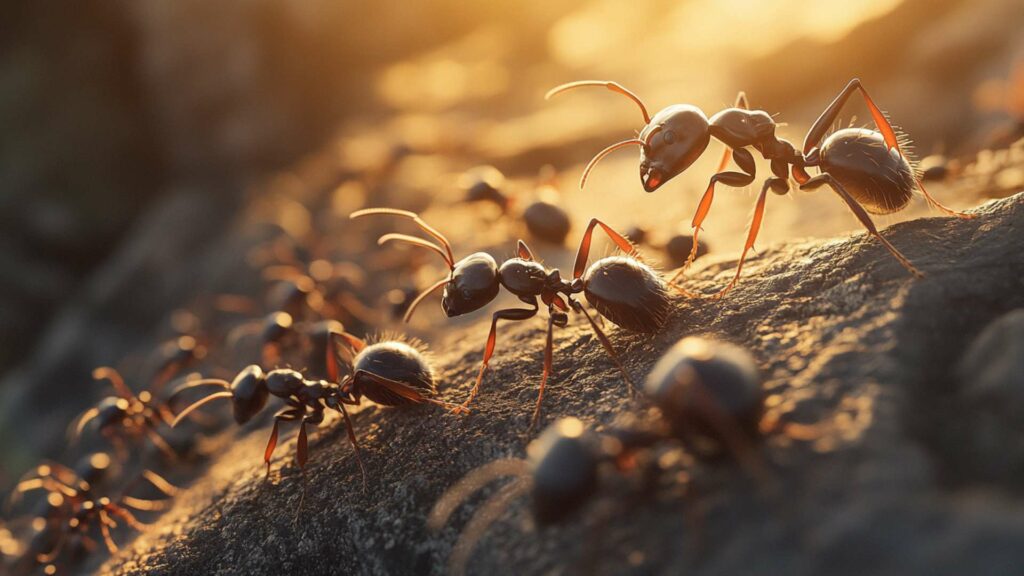
What Eats Ants? Find Out in Nature’s Food Chain
Discover the intriguing world of ant predation and explore what eats ants in the wild. From birds and insects to various creatures, nature has its own way of balancing the ecosystem. If you’re curious about ant predators, check out our detailed insights.
What Smell Do Ants Hate? Natural Repellents Revealed
Ants are known for their keen sense of smell, but there are certain scents they despise. Learn about the odors that deter ants from invading your space. Find out which natural repellents can help you keep your home ant-free.
What Do Fire Ants Look Like? Identification Tips
Identifying fire ants is essential, especially if they’ve invaded your property. This article provides you with detailed descriptions and images to help you recognize these stinging insects. Learn to distinguish fire ants from other ant species.
What Do Carpenter Ants Eat? Insights into Their Diet
Carpenter ants play a crucial role in the ecosystem. But what do carpenter ants eat? Explore their dietary habits and the significance of these ants in the circle of life. Delve into their nutrition and feeding patterns.
What Do Ants Do in the Winter? A Fascinating Peek into Ant Hibernation
Ants exhibit intriguing behavior during the winter months. Uncover the secrets of ant hibernation and how these tiny creatures survive the cold season. Learn how they adapt to changing conditions.
What Do Ants Smell Like? Decoding the Aromas of Ants
Have you ever wondered what ants smell like? This article delves into the unique fragrances that ants emit. Discover the scents associated with ant colonies and their roles in communication.
What Do Ant Eggs Look Like? Exploring the World of Ant Reproduction
Ant reproduction is a fascinating process, and ant eggs play a crucial role in the colony’s life cycle. Learn about the appearance of ant eggs and their significance within the ant community.
What Are Ants Attracted To? Insights into Ant Behavior
Ants are attracted to a variety of substances. Explore what ants are attracted to and how understanding their preferences can help you keep your home ant-free. Discover what ants find irresistible.
What to Put on Ant Bites? Remedies for Soothing Ant Stings
Ant bites can be painful and itchy. Find out what to put on ant bites to alleviate discomfort and reduce swelling. Explore home remedies and treatments for soothing the irritation caused by ant stings.
Anatomy and Physiology of Ants
External Anatomy of Ants (head, thorax, abdomen)
Ants, those fascinating little creatures that scurry about in our gardens and picnic areas, have a rather intriguing external anatomy. Let’s start with their head, which houses the ant’s eyes and mouthparts. These tiny eyes have a multitude of lenses that allow ants to detect movement and differentiate between light and darkness.
Moving down to the thorax, you’ll notice three pairs of legs that enable ants to traverse various surfaces with remarkable agility. The abdomen, located at the rear end of the ant’s body, contains vital organs such as the heart and digestive system.
Specialized Body Parts (antennae, mandibles)
Ants rely on their specialized body parts to carry out their daily activities. One remarkable feature is their antennae – those thin and flexible appendages protruding from their heads and wings.
These antennae serve as sensory organs capable of detecting chemicals in the environment. By analyzing pheromones left behind by other ants or sensing vibrations from nearby objects, ants can communicate important messages about food sources or danger within their colony.
Another characteristic feature is their mandibles – powerful jaws located on either side of an ant’s head. Mandibles are essential for many tasks such as nest-building or defending against predators.
Different ant species may have variations in mandible shape or size depending on their specific needs. Some ants use these mandibles to bite into leaves or seeds they consume as part of their diet; others employ them as weapons when defending against predators or other competing colonies.
Internal Anatomy (digestive system, respiratory system)
While we may primarily see ants scurrying around on the surface, it is what lies beneath that truly showcases their complexity. The digestive system allows ants to process various food sources, whether it be sugary nectar from flowers or other types of organic matter.
Once ants consume food, it travels through their esophagus and enters the midgut, where enzymes break down the nutrients for absorption. Waste material then passes through the hindgut and is excreted.
Ants don’t have lungs like we do; instead, they rely on a network of tubes called tracheae for respiration. These tracheae extend throughout their bodies, delivering oxygen directly to individual cells.
Ants breathe by contracting and expanding their abdominal muscles, causing air to flow in and out of small holes called spiracles. This efficient respiratory system ensures that ants receive enough oxygen to support their energetic lifestyle.
Understanding the anatomy and physiology of ants offers us a glimpse into their intricate adaptations that enable them to thrive in various environments. From their external body parts like antennae and mandibles to their internal systems for digestion and respiration, every aspect contributes to their remarkable survival skills within the diverse world they inhabit.
Ant Colonies and Social Structure
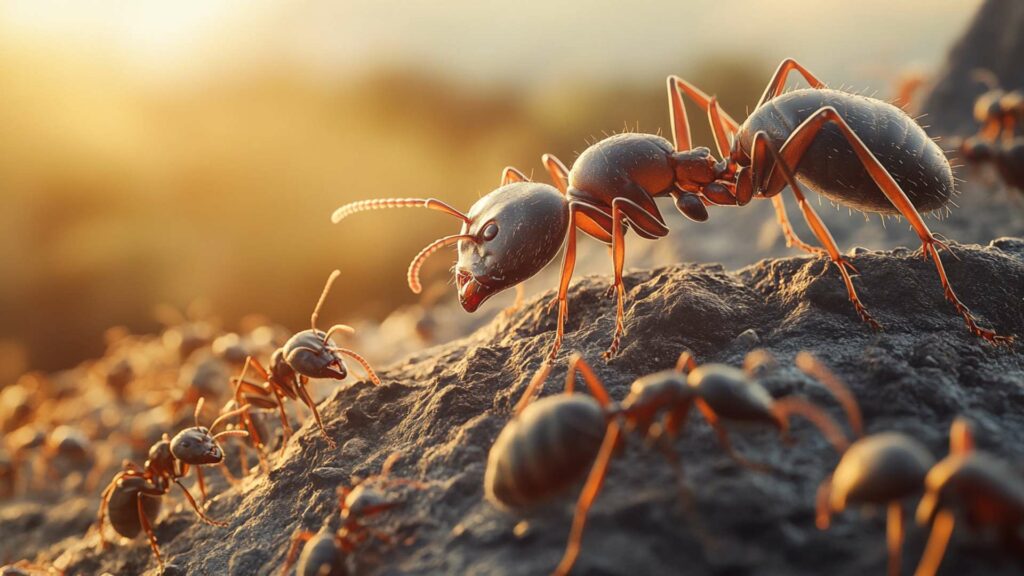
Ant colonies are bustling communities with a well-defined division of labor among their members. Each ant has a specific role to fulfill based on its age and physical abilities.
The individuals can be categorized into three main castes: queens, workers, and male ants. The queens hold the highest position in the hierarchy, responsible for reproduction and laying eggs.
They have enlarged abdomens to accommodate their extensive egg-laying capabilities. The majority of ants in a colony are worker ants, tirelessly working to ensure the survival and growth of their community.
Workers carry out various tasks such as foraging for food, caring for the young (brood), defending the colony against intruders, and maintaining the nest structure. These worker ants engage in an impressive array of duties that require specialized adaptations suited for their assigned roles.
Roles of queen ants, worker ants, and male ants
Queen ants are essential to the survival of ant colonies as they lay eggs which give rise to new generations. Their primary function is reproduction, but they also release pheromones that regulate behavior within the colony.
In some species like fire ant sting and ants, an individual queen may produce offspring over many years while in others such as odorous house ants; multiple queens coexist within a colony. Worker ants form the backbone of ant colonies by performing most tasks necessary for survival.
They have diverse functions depending on their age: younger workers usually care for brood while older ones assume more demanding roles like foraging or defense against predators or other pests that may endanger their home. These remarkable insects exhibit immense cooperation within their society.
Male ants serve one purpose – mating with virgin queens during a short period known as “nuptial flight.” After this event occurs, males typically die shortly thereafter since they have fulfilled their reproductive role. Male flying ants are usually smaller in size compared to workers and have winged bodies to facilitate their aerial quests for mates.
Communication methods among ants (pheromones, touch)
Ants communicate effectively through a variety of methods, with pheromones playing a crucial role in relaying messages. Pheromones are chemical substances secreted by ants that transmit information about food sources, danger signals, or even marking territories. These scent trails allow ants to navigate efficiently as they follow the odor cues laid down by their fellow colony members.
Besides pheromones, touch is another important communication method among ants. Ants use their antennae and legs to engage in tactile interactions.
For instance, when two ants meet or encounter an obstacle while foraging, they may briefly touch each other’s antennae to exchange information. This physical contact helps coordinate their activities and maintain social cohesion within the ant colony.
Ant colonies possess a well-structured social hierarchy where each member has specific tasks based on its caste and abilities. Queen ants govern reproduction while worker ants perform various duties essential for the survival of the community.
Communication is facilitated through the use of pheromones and tactile interactions such as antennal touching. The intricate social structure and communication systems of ant colonies contribute to their remarkable efficiency as effective societies within the natural world.
Nesting Habits and Architecture
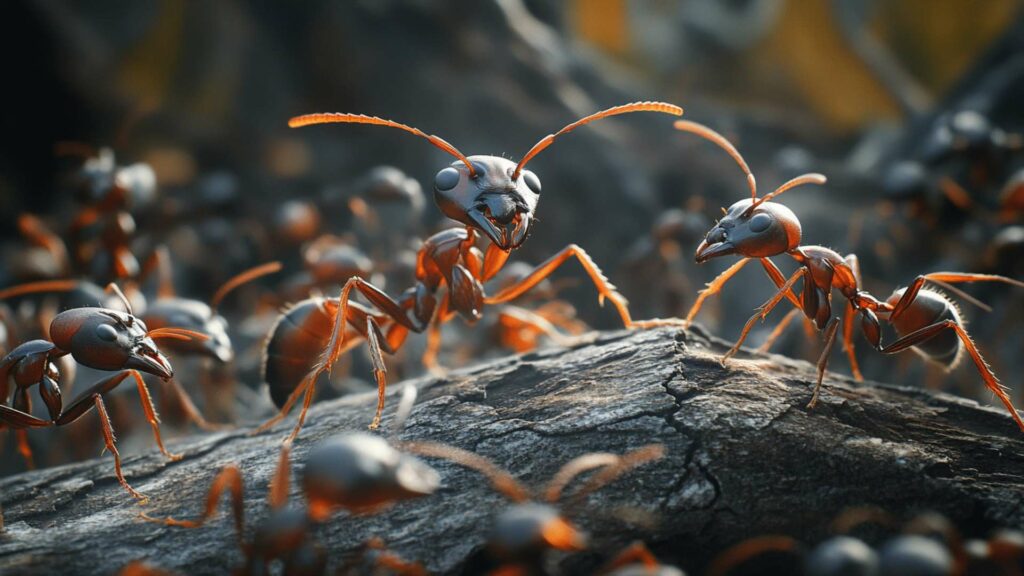
Types of Ant Nests: Mounds and Tunnels
When it comes to nesting, ants exhibit remarkable diversity in their architectural choices. Some ants are known for creating conspicuous mounds on the ground, while others prefer intricate tunnel systems beneath the surface. The variation in nest types is influenced by factors such as ant species, habitat, and resource availability.
Let’s explore these fascinating structures further. Mound-building ants, as their name suggests, are red ants that construct nests that rise above the ground surface.
These impressive mounds can be made from different materials, depending on the ant species and environmental conditions. For instance, some ants use soil particles mixed with their saliva to build elaborate mounds that provide a stable home for their colonies.
These mounds often have complex internal chambers where ants live and rear their young. In contrast to mound builders, tunnel-dwelling ants opt for a more discreet living arrangement underground.
These industrious insects meticulously excavate intricate tunnels into the ground, creating a hidden haven for their colonies. The tunnel networks serve various purposes, including providing protection against predators and extreme weather conditions while also offering controlled access to food sources outside the nest.
Construction Process and Materials Used by Different Ant Species
The construction process of ant nests involves an impressive display of cooperation among colony members. Different species employ various methods and materials suited to their particular needs.
For instance, the carpenter ant, ants are renowned for carving out galleries within decaying wood or even living trees. Their strong mandibles enable them to bite through wooden fibers effortlessly.
As they excavate these tunnels, carpenter ants remove sawdust-like debris from the galleries—an unmistakable sign of infestation that can alert humans to potential structural damage in buildings or trees. In contrast, leafcutter ants have mastered an entirely different artistry of nest building.
These remarkable ants cut and carry leaf fragments back to their underground chambers. These leaves function not as food but rather as substrate for the cultivation of a special fungus, which serves as their primary source of nutrition.
The intricate chambers within these nests are carefully maintained at optimal temperature and humidity levels to support the growth of the fungus gardens. Overall, the nesting habits and architecture of ants demonstrate an astonishing range of adaptations to various ecological niches.
From towering mounds to labyrinthine tunnels, each ant species showcases its ingenuity in constructing a home that meets its specific requirements. The intricacy and diversity observed in ant nest construction never cease to amaze and fascinate us.
Foraging Behavior and Food Sources
When it comes to finding food, ants are remarkably organized and efficient. They use a variety of methods, but one of their most fascinating techniques is the utilization of trail pheromones. These chemical signals, secreted by ants as they move along in search of sustenance, serve as a guide for other members of the colony.
The trails can be detected by the sensitive antennae of fellow workers, who then follow these invisible pathways from their nest to the food source. This remarkable communication system ensures that no time is wasted in locating nourishment.
Diet preferences and food storage techniques
Ants have diverse dietary preferences depending on the species and their specific ecological niche. While some ant species are omnivorous, feeding on both plant material and insects, others might have a more specialized diet. For instance, certain ant species have evolved a mutualistic relationship with aphids or honeydew-producing insects.
These ants protect these insects and “farm” them for their honeydew secretions—a sugary substance that serves as an important food source for the ants. Food storage is also an essential aspect of ant behavior.
Some ant colonies have specialized chambers within their nests where they store excess food items such as seeds or dead insects. This stored food acts as reserves during times when resources might be scarce or when environmental conditions hinder foraging activities.
Ants display remarkable foraging behavior through their sophisticated use of trail pheromones to find food sources efficiently. Their diet preferences vary across different species; some may have a broad range while others specialize in specific foods like aphid honeydew or seeds.
Additionally, their ability to store excess food enhances their resilience against fluctuating environmental conditions. Understanding these aspects sheds light on the remarkable adaptability and resourcefulness of ants in nature and their crucial role within the ecosystem.
Mutualistic Relationships with Other Species
In the intricate tapestry of nature, ants have forged fascinating partnerships with aphids and other honeydew-producing insects. These tiny farmers have mastered the art of mutualism, a relationship in which both parties benefit.
The story begins with aphids, small sap-sucking insects that feed on the sap of plants using their needle-like mouthparts. As they dine on the plant’s sugary goodness, they excrete a sugar-rich substance called honeydew from their rear end.
Here’s where our industrious ants come into play: they have developed a sweet tooth for this delicious nectar-like secretion. Intrigued by this sugary feast, ants cultivate herds of aphids in a unique form of agriculture.
They tend to these miniature “cows,” protecting them from predators and transporting them to prime feeding locations on plants. The relationship is not one-sided though; while enjoying a constant supply of honeydew, the ants reciprocate by providing protection to these precious insects.
They ward off potential threats such as ladybugs or parasitic wasps that would otherwise harm or devour the aphids. In return, aphids receive security and can blissfully continue their sap-sucking activities uninterrupted.
Ants’ role in seed dispersal through seed caching behavior
While we often associate seed dispersal with birds or wind, it may come as a surprise that ants also possess an essential role in this ecological process through their remarkable seed caching behavior.
Some plant species have evolved specialized adaptations to exploit ant services for spreading their seeds far and wide. Picture this: beneath towering trees in lush forests or amidst a verdant meadow, ants scurry around, collecting seeds and diligently carrying them to their nests.
These industrious insects, known as scatter-hoarders, play a crucial part in enhancing plant diversity by dispersing seeds to new locations. The process begins when seeds fall to the ground.
Opportunistic ants seize the moment, gathering the fallen treasures and transporting them back to their underground abodes. In an astonishing feat of memory and navigation, ants create a stockpile of seeds within their nests or specialized chambers known as granaries.
But why would ants go through all this trouble? The answer lies in their resourcefulness.
By caching these seeds underground, they protect them from being devoured by other herbivores or fungi. In many cases, some of these buried seeds are forgotten or left behind by the ants.
This forgetfulness becomes nature’s gift for future generations – allowing the germination and growth of new plants in distant locations, thereby increasing biodiversity. In this intricate dance between plants and ants, both parties gain advantages.
Plants benefit from increased dispersal distances and reduced competition with neighboring individuals while ensuring their genetic survival. Meanwhile, ants secure a reliable food source within their mounds while indirectly shaping the landscape around them.
So next time you marvel at the vast array of flora encompassing our natural habitats, remember that beneath your feet lies an army of tiny architects responsible for nurturing this remarkable biodiversity: none other than our industrious ant allies. (Word count: 652)
Ants as Predators and Prey

Ants, despite their small size, are astute predators and exhibit remarkable hunting strategies. They possess sharp mandibles that enable them to seize and immobilize their unsuspecting prey.
Some species like army ants display highly organized group predation, forming formidable raiding parties that can overrun entire insect colonies. They work together seamlessly, encircling their victims, and overwhelming them with sheer numbers and relentless aggression.
Other ants employ a more patient approach to hunting. They patiently stalk their prey until the opportune moment arises, before swiftly launching an attack.
Some species have even been observed using tools made of leaves or twigs to capture elusive insects that hide in crevices or burrows. One fascinating example of this predatory behavior is the trap-jaw ant.
These ants have specialized jaws that snap shut at incredible speeds to capture their prey in a fraction of a second! This rapid movement is one of the fastest recorded in the animal kingdom.
Predation on ant colonies by predators such as anteaters or spiders
While ants may be skilled predators themselves, they are not exempt from becoming prey for larger animals. Predators such as anteaters and spiders view ants as a tasty meal to eat, due to their abundance and nutritional value.
Anteaters employ long tongues coated with sticky saliva to slurp up and kill large numbers of ants during feeding frenzies. Equipped with sharp claws for digging into nests, these long-snouted mammals can decimate an ant colony within minutes.
Spiders also pose a significant threat to ant colonies. They skillfully spin intricate webs near ant trails or over nests, waiting patiently for unsuspecting workers to become entangled in their silk trap.
Once ensnared, the spiders inject venom into their helpless victims before feasting upon them at leisure. Despite the risks, ants have evolved various defense mechanisms to protect themselves and other ants enter their colonies from predators.
Some species have developed stingers or powerful jaws to deter potential attackers. They also employ chemical signals to alert colony members of impending danger, allowing them to mount a coordinated defense.
The Perils of Predation
As ants go about their daily lives, they are entangled in a complex web of predator-prey relationships. From exhibiting cunning hunting techniques to dealing with formidable foes, ants’ survival depends on their ability to navigate these dangerous interactions in the natural world.
Impact on Ecosystems
Ants may be tiny, but their impact on ecosystem health is far-reaching. One crucial role they play is in nutrient cycling through decomposition. When ants come across dead organisms or organic matter, they waste no time turning it into valuable nutrients for the soil.
These resourceful insects break down decaying plant material and animal remains, accelerating the decomposition process. By doing so, ants release essential nutrients back into the environment, enriching the soil and supporting plant growth.
The digestive systems of ants are uniquely adapted for decomposition. After feeding on organic material, the food passes through their digestive tract where it undergoes biochemical reactions facilitated by enzymes.
These reactions help break down complex molecules into simpler ones that can be absorbed and utilized by plants. In this way, ants act as nature’s recyclers, efficiently processing organic matter that would otherwise accumulate and hinder ecological processes.
Effect on Plant Pollination Through Foraging Habits
While ants are not typically considered primary pollinators like bees or butterflies, they play a notable role in assisting with plant reproduction through their foraging habits. Some plants have evolved intricate relationships with specific ant species to ensure successful pollination. These plants produce nectar-rich flowers that attract ants as potential pollinators.
As worker ants visit these flowers in search of nectar to feed their colonies, they inadvertently transfer pollen grains from one flower to another. This accidental pollination mechanism greatly benefits both plants and ants involved in these mutualistic relationships.
Additionally, certain ant species possess specialized structures called elaiosomes on the seeds of some plants. Ants are attracted to these structures because they contain lipids and proteins that serve as a valuable food source for their colonies.
The ants carry the seeds back to their nests where they consume the elaiosomes but discard the seeds. This seed dispersal process, known as myrmecochory, helps plants colonize new areas and enhances their chances of survival.
Ants have a substantial impact on ecosystems through their contribution to nutrient cycling and their role in plant pollination. Their efficient decomposition of organic matter ensures the recycling of essential nutrients in the environment.
Furthermore, by inadvertently pollinating flowers and assisting with seed dispersal, ants play a significant part in the reproductive success and distribution of numerous plant species. It is fascinating to witness these small creatures engaging in such crucial ecological processes that shape our natural world.
Ant Species Diversity
Ants, as a group, are remarkably diverse and can be found on every continent except Antarctica. These tiny creatures have successfully colonized nearly every terrestrial habitat on Earth, from deserts to rainforests, grasslands to mountains.
With over 12,000 known species globally, ants are among the most abundant insects in the world. They play crucial roles in various ecosystems by participating in nutrient cycling, seed dispersal, and even acting as predators or prey for other organisms.
Each geographic region has its own unique mix of ant species. For example, in tropical rainforests where biodiversity is high, you’ll find an astonishing variety of ants coexisting.
The Amazon rainforest alone is home to around 1,300 different ant species! On the other hand, temperate regions might have fewer ant species but still exhibit interesting ecological interactions.
Examples of unique ant species from different habitats
In different habitats worldwide, fascinating ant adaptations and behaviors have evolved to suit specific environments. Let’s explore a few examples:
1. Army Ants (Ecitoninae): Found predominantly in tropical forests of Central and South America, army ants are known for their aggressive hunting behavior. These nomadic ants form massive raiding columns that can contain millions of individuals. They move through the forest floor in search of prey like spiders and insects, devouring everything in their path.
2. Leafcutter Ants (Atta genus): Native to Central and South America as well as parts of North America and the Caribbean Islands, leafcutter ants are remarkable farmers. They cut pieces of leaves from plants and carry them back to their underground nests where they use them to cultivate a specialized fungus that serves as their primary food source.
3. Weaver Ants (Oecophylla genus): These ants are found in tropical and subtropical regions of Africa, Asia, and Australia. They construct elaborate nests by weaving leaves together using silk produced by their larvae. Weaver ants are known for their aggressive territorial behavior, forming living bridges with their bodies to connect separate nesting sites. These examples represent just a fraction of the diversity and fascinating behaviors exhibited by ant species across the globe.
Exploring different habitats unveils a world of intricate ecological relationships and evolutionary adaptations within the vast realm of ants. Remember, ants play vital roles in maintaining ecosystem balance and functioning, making them an essential component of our natural environment.
Human-Ant Interactions
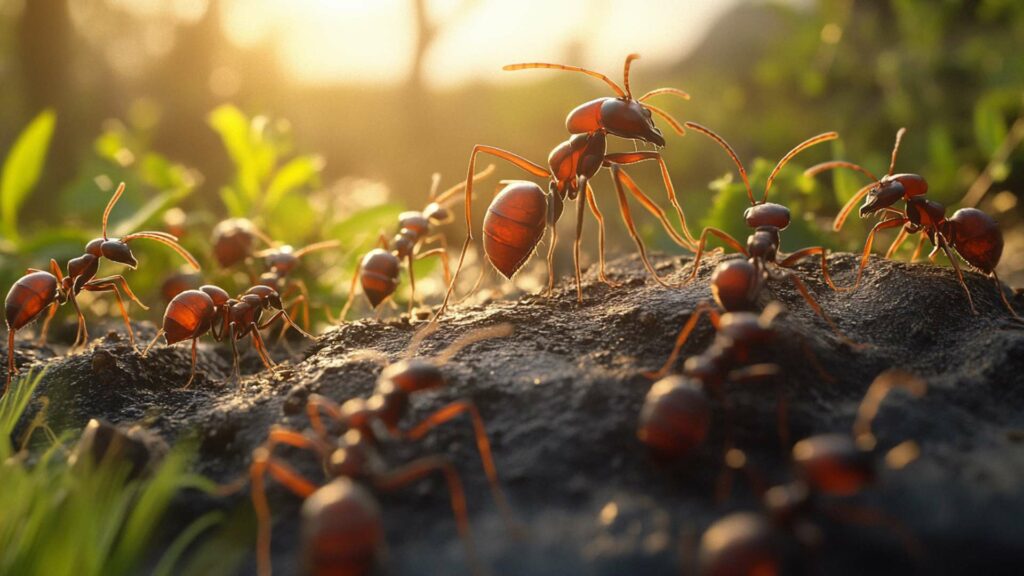
Impact on agriculture
When it comes to human-ant interactions, one area where their presence can be both a blessing and a curse is in agriculture. Ants play a crucial role in the ecosystem by helping with nutrient cycling through their scavenging and decomposition activities. However, some ant species can also cause trouble for farmers.
Certain ants like the infamous fire ants are known to damage crops by feeding on seeds or attacking plant root systems. In addition to direct crop damage, ants can also indirectly impact agriculture by tending to other pests.
For example, certain ant species maintain mutualistic relationships with aphids or scale insects that produce honeydew. These sticky secretions attract ants, creating a symbiotic relationship where the ants protect the aphids from predators while benefiting from their sugary excretions.
While this may seem harmless at first glance, large populations of aphids can seriously weaken plants and reduce crop yields. On the bright side, not all human-ant interactions in agriculture are negative.
Some ant species actually act as biological control agents by preying on other pests that harm crops. For instance, certain predatory ant species effectively control populations of insect pests such as caterpillars or termites that would otherwise cause significant damage to agricultural crops.
Conclusion
Ants play a multifaceted role in our environment and agriculture. While some species may pose challenges for farmers due to their destructive feeding habits or connections with other pests like aphids, it’s important to remember that many ant species contribute positively to our ecosystems by aiding in nutrient cycling and acting as natural pest controllers.
By understanding these complex interactions between humans and ants, we can find ways to strike a balance that benefits both agricultural productivity and the preservation of these fascinating creatures’ ecological roles. Remember, despite occasional encounters where an unfortunate bite or sting from fire ant may occur, most ants won’t pose a significant threat to humans.
So, next time you see ants marching in your garden or encountering them outdoors, take a moment to appreciate their intricate social structures and the valuable services they provide to our environment. Let’s embrace the harmony between humans and ants, respecting their place in nature’s tapestry and finding ways to coexist peacefully.
Frequently Asked Questions:
Ants play crucial roles in the environment as they help in soil aeration, seed dispersal, and pest control.
They inhabit various natural environments, from forests to grasslands.
While we could technically survive without ants, their absence would disrupt ecosystems, affecting agriculture and biodiversity.
In ecosystems, ants contribute to nutrient cycling, plant growth, and decomposition.








